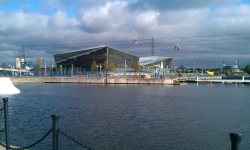Integration is the key

Only a truly integrated renewable-energy system for heating and cooling buildings can deliver the carbon savings required in the future, says Chris Davidson of GI Energy.
The drive to cut the carbon footprints of Britain’s buildings is gathering pace; regulations are tough and getting tougher. People are waking up to the realisation that more action needs to be taken if the UK is to meet its target of reducing greenhouse-gas emissions by 80% by 2050, relative to 1990 levels.
With the energy consumed in buildings accounting for more than a third of the UK’s carbon emissions, it is inevitable that pressure is intensifying on builders and developers to deploy more energy-efficient heating, cooling and lighting.
Already London Mayor Boris Johnson has turned up the heat. All new builds in the capital now have to produce carbon savings 40% above those stipulated in Part L of the national Building Regulations, and there are plans to ensure that from 2016 all new homes in the capital will be zero-carbon.
Where London leads, others will follow.
 |
| The Siemens Crystal building in London is powered entirely by renewable energy and includes 1580 crystalline photovoltaic panels on the roof and ground-source heat pumps. |
There are also pressures emanating from the boardroom. Companies are cutting carbon footprints to demonstrate their corporate social responsibility (CSR). FTSE100 company shareholders expect regular reports on sustainability.
One thing is becoming clear on the ground — only a truly integrated renewable energy solution will produce the scale of carbon savings required.
This world of smaller carbon footprints cannot be achieved by adopting one renewable technology alone. Nor will it necessarily work by mixing a variety of renewable technologies together and hoping they will work in harmony — the ‘kitchen-sink’ approach.
All energy-efficiency, renewable and sustainable energy technologies have their strengths and weaknesses. By deploying a truly integrated mix of these technologies we can often overcome their individual weaknesses, but it is crucial to understand that simply deploying a mix of technologies alongside one another we rarely achieve the same benefits.
Some mixes are problematic. Solar photovoltaic and solar thermal can conflict with combined heat and power, for example, as can biomass. Passive ventilation cannot be used readily where a building has ventilation heat recovery nor does it work well with ground-source heat pumps.
However, there are opportunities where technologies, properly combined, truly complement one another. Take ground-source energy systems and combined heat and power, for example.
 |
| A feature of One New Change in central London is this ground-source energy system. |
A major drawback of CHP is that it produces heat as well as electricity; while the proportions of each can be varied, some heat is always produced even when it is not needed. In hot weather, this heat often goes to waste. However, it can be stored — and for a long time — underground in the earth if the CHP is combined with a ground-source energy system. The ground-source energy system can re-cycle heat into the ground from where, perhaps months later, it can be extracted again to heat the building.
That is one example of true technology integration.
There are huge rewards to be reaped for those who intelligently combine renewable technologies across heating, cooling, lighting, catering, hot water and office equipment — in both new build and retrofit.
Carbon footprints in schools and retail and heritage sites can be halved; in hospitals and universities they can be cut by 40%; in commercial developments, government buildings, public offices and sports buildings they can be cut by more than a third.
And all by using a mix of technologies which have a simple payback of less than three years or an Internal Rate of Return greater than 8%, once fuel cost savings, financing options, grants and incentives are considered.
The GI Energy team undertook the analysis used as the baseline for carbon emission figures for 2005 published by the Carbon Trust in 2009 in its document ‘Building the future, today — transforming the economic and carbon performance of the buildings we work in’, which is widely regarded as a definitive source for carbon-performance baseline data and strategies towards the UK’s legally binding 2020 carbon reduction targets.
 |
| Renewable energy meets much of the heating and cooling requirements of the Earth Sciences Building at the University of Oxford. |
Of course, no building behaves as designed, and no building remains the same throughout its lifetime. When combining technologies, whether conventional or clean tech, it is important to have a robust control and monitoring package in order to optimise carbon savings.
Such monitoring can help energy managers to answer questions such as:
• ‘Is our ventilation strategy working with our heating and cooling generation systems?’
• ‘Would it be better to use a “set-back” strategy rather than turning off everything overnight?’
However it is essential to analyse the data and form clear strategies for improving performance. That is one of the keys to cutting carbon footprints in the long term.
Chris Davidson is development director of GI Energy.







